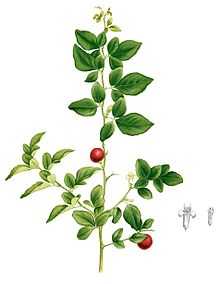Triphasia
From Wikipedia, the free encyclopedia
| Triphasia | |
|---|---|
 | |
| T. trifolia foliage and fruit | |
| Scientific classification | |
| Kingdom: | Plantae |
| (unranked): | Angiosperms |
| (unranked): | Eudicots |
| (unranked): | Rosids |
| Order: | Sapindales |
| Family: | Rutaceae |
| Subfamily: | Aurantioideae |
| Tribe: | Citreae |
| Genus: | Triphasia Lour. |
| Species | |
|
See text | |
Triphasia is a small genus of three species in the family Rutaceae, related to Citrus. The genus is native to southeastern Asia and New Guinea.[1][2]
They are evergreen shrubs growing to 1-3 m tall, with trifoliate leaves. The flowers are fragrant, white, with three to five petals. The fruit is an edible red hesperidium similar to a small Citrus fruit.[2][3]
- Species
- Triphasia brassii (C.T.White) Swingle – New Guinea
- Triphasia grandifolia Merr. – Philippines
- Triphasia trifolia (Burm.f.) P.Wils. – Malaysia
References
- ↑ Germplasm Resources Information Network: Triphasia
- ↑ 2.0 2.1 Huxley, A, ed. (1992). New RHS Dictionary of Gardening 3: 697. Macmillan ISBN 0-333-47494-5.
- ↑ Plants for a Future: Triphasia trifolia
This article is issued from Wikipedia. The text is available under the Creative Commons Attribution/Share Alike; additional terms may apply for the media files.